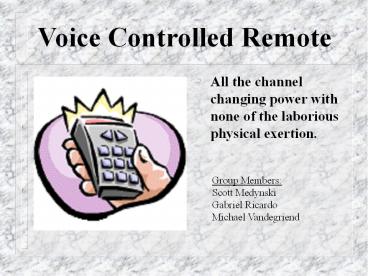Voice Controlled Remote PowerPoint PPT Presentation
Title: Voice Controlled Remote
1
Voice Controlled Remote
- All the channel changing power with none of the
laborious physical exertion.
Group Members Scott Medynski Gabriel
Ricardo Michael Vandegriend
2
Hierarchy of Design
Voice Controlled Remote
Control Path
Voice Input
Speech Processing
IR Interface
3
Characteristics of Speech
- Amplitude variations
- Frequency variations
- Continuous in frequency domain
- Most of the energy is within 100Hz to 4kHz
- Requires gt8kHz sampling for intelligible speech
4
Our Speech Algorithm
- Isolated word - cannot distinguish important
areas in a stream of uninterrupted speech - Small vocabulary - in the zero to tens of words
region - Up, Down, Power, Surf - Training Required - tells the device what the
command sounds like - Speaker Dependent - re-training required for
separate user
5
The Voice Input
- Condenser microphone
- Signal is amplified approximately 6000x
- Sampling rate 8 kHz
- 8 bit linear conversion
6
Word Boundary Detection
- Samples continuously
- Has the threshold level been reached?
- Begin analyzing the data
- Is the threshold level being reached very often?
- Stop analyzing the data
7
Zero Crossings
- One transition from positive to negative or
vice-versa - Algorithm to determine the frequency of the
signal - Frequency inversely proportional to the period
8
Energy Analysis
- The energy of the signal is the amplitude squared
(Parsevals theorem). - we used absolute value of amplitude.
- Real-time calculation (as it is received).
9
The Recognition Process
Compare the characteristics of the sample
against Command1
The command most similar to the recognized word.
Compare the characteristics of the sample
against Command2
The command that was spoken
Compare the characteristics of the sample
against Command3
The command most similar to the recognized word.
Compare the characteristics of the sample
against Command4
10
The Infra-Red Beam
- Detects and stores codes for common Sony TVs
- Utilizes blind copycat method of IR memory, no
decoding occurs - Method easily modified to other IR protocols
11
General A/V IR coding schemes
- 38-40kHz carrier at ? 940nm wavelength
- Carrier output is gated by bit stream.
- Most protocols use Pulse Width Modulation for bit
encoding. - Logic 1s coded as T (un-modulated) followed by
2T (modulated). Where T ? 550?s - Logic 0s coded as T (un-modulated) followed by
T (modulated). - Various bit lengths, start and end sequences.
12
Gated modulation to Carrier
- 2T
- T
- T
- T
13
Bit stream for Power command
14
Bit stream for Channel up command
15
Common North American IR code sequence
16
The Control Path
- Implemented in two Moore state machines
- Training/Initialization
- Active/Recognition
17
The Surf Function
- Start and stop the function with the utterance of
the command SURF - Enables a three-second preview of each channel
- Risk of developing carpal-tunnel syndrome
decreases sharply!

